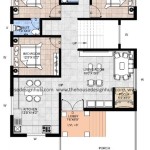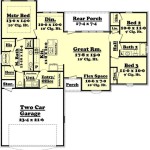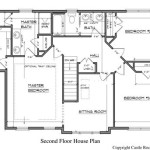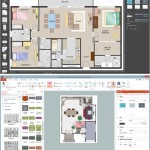What Is A 2 Bedroom Split Floor Plan?
A 2-bedroom split floor plan is a residential layout commonly found in apartments, condominiums, and single-family homes. Its defining characteristic lies in the strategic separation of the two bedrooms, positioning them on opposite ends of the living space. This design prioritizes privacy and noise reduction, making it a popular choice for diverse living arrangements.
Unlike floor plans where bedrooms are adjacent, the split floor plan incorporates a buffer zone, typically consisting of the living room, dining area, kitchen, or even a den, between the two sleeping quarters. This separation minimizes the direct transference of sound and visual disturbances, contributing to a sense of individual space and comfort for the occupants.
The demand for split floor plans has grown steadily as more individuals seek living situations that balance shared spaces with private retreats. This design caters to the needs of roommates, families with older children, and individuals who frequently host guests, offering a functional and comfortable living environment for all involved.
Evaluating a floor plan involves understanding its intended use and assessing how well it meets the occupants' specific lifestyle requirements. While a split floor plan offers inherent advantages, its suitability depends on individual preferences and the dynamic of the household. Analyzing the layout, dimensions, and flow of the space is crucial in determining whether it aligns with the desired living experience.
Key Point 1: Enhanced Privacy and Sound Reduction
The foremost advantage of a 2-bedroom split floor plan is the enhanced privacy it provides. By physically separating the bedrooms, the layout creates distinct zones within the living space. This separation translates to reduced noise transference between the rooms, allowing occupants to engage in different activities without disturbing one another. For instance, one roommate can host guests in the living room while the other can sleep undisturbed in their bedroom.
This privacy extends beyond just noise reduction. The spatial separation also offers visual privacy. Residents can maintain a higher degree of personal space and solitude within their bedrooms without feeling constantly exposed to other occupants' activities. This is particularly beneficial for individuals who value personal space or require a quiet environment for work or study.
Consider a scenario where one occupant works from home. A split floor plan enables them to conduct meetings and concentrate on their tasks without being disrupted by the activities taking place in the other bedroom or the common areas. Similarly, if one roommate prefers to go to bed early while the other enjoys staying up late, the split layout minimizes the potential for conflict and promotes harmonious cohabitation.
The effectiveness of this privacy feature is also influenced by the construction materials and soundproofing techniques employed in the building. Thick walls and insulated floors can further reduce noise transmission, maximizing the benefits of the split floor plan design. However, even without specialized soundproofing, the inherent separation provides a noticeable improvement compared to floor plans with adjacent bedrooms.
In essence, the split floor plan functions as a buffer, creating a psychological and physical distance between the bedrooms. This distance fosters a sense of autonomy and control over one's personal space, contributing to a more comfortable and relaxed living environment. This benefit is especially crucial in shared living situations where maintaining individuality and personal boundaries is paramount.
Key Point 2: Suitability for Diverse Living Arrangements
The versatility of a 2-bedroom split floor plan makes it well-suited for a variety of living arrangements. Its adaptability caters to the needs of different household compositions, ranging from roommates to families with older children and individuals who frequently entertain.
For roommates, the split layout is an ideal solution for maintaining independence and preventing conflicts. Each roommate enjoys a private bedroom and often a dedicated bathroom, allowing for personal space and independent routines. The shared living areas, such as the kitchen and living room, become communal spaces for socializing and shared activities, while the bedrooms remain sanctuaries for rest and relaxation.
Families with older children also appreciate the benefits of a split floor plan. As children mature, they often require more personal space and privacy. Separating the bedrooms allows parents and children to have their own dedicated areas within the home, fostering a sense of autonomy and reducing the likelihood of friction. This is particularly beneficial for teenagers who value their independence and require a quiet space for studying and personal activities.
Furthermore, individuals who frequently host guests find the split floor plan particularly appealing. The separation of the guest bedroom from the master bedroom ensures that both the host and the guest have their own private spaces. Guests can enjoy a comfortable and secluded area without feeling like they are intruding on the host's personal space. This layout enhances the overall guest experience and promotes a more relaxed and enjoyable stay.
The overall functionality of the split floor plan also allows for flexible usage of the second bedroom. It can be easily adapted into a home office, a guest room, a hobby space, or a dedicated workout area. This versatility makes it a valuable asset for individuals who have diverse needs and require a space that can be easily transformed to suit their changing lifestyle.
Key Point 3: Potential Drawbacks and Considerations
While a 2-bedroom split floor plan offers numerous advantages, it is important to acknowledge the potential drawbacks and considerations that may influence its suitability for certain individuals or families. Understanding these limitations is crucial for making an informed decision about whether this layout aligns with specific needs and preferences.
One potential drawback is the potential for reduced interaction among household members. While the separation of bedrooms promotes privacy, it may also lead to less spontaneous interaction and shared time. If the occupants prioritize close proximity and frequent interaction, a different floor plan that fosters more interconnectedness may be more suitable. This is particularly relevant for families with young children who require close supervision and constant interaction with their parents.
Another consideration is the potential for uneven distribution of living space. In some split floor plans, one bedroom may be significantly larger or have more desirable features, such as a walk-in closet or an ensuite bathroom, than the other. This can lead to resentment and conflict, particularly in shared living situations where both occupants contribute equally to the rent or mortgage. It is important to carefully assess the dimensions, features, and overall quality of both bedrooms before committing to a split floor plan.
Furthermore, the placement of the common areas, such as the living room and kitchen, can also be a factor. If these areas are located far from one or both of the bedrooms, it may create a sense of isolation or inconvenience. Consider the flow of the floor plan and how easily occupants can access the shared spaces from their respective bedrooms. A well-designed split floor plan should maintain a balance between privacy and accessibility.
Accessibility for individuals with mobility limitations is another important consideration. A split floor plan that requires navigating long hallways or stairs to access different parts of the living space may not be suitable for those with physical disabilities. Assess the layout for potential barriers and ensure that it meets the accessibility requirements of all occupants.
Finally, the cost of a split floor plan may be higher than other layouts, particularly in desirable locations or newly constructed buildings. The increased demand for this type of floor plan can drive up prices, making it less affordable for some individuals. It is important to weigh the benefits of the split layout against the associated costs and determine whether it represents the best value for the money.

The Aloha 2 Split Bedroom Floor Plan Small House Plans Tiny

The Aloha 2 Split Bedroom Floor Plan

Plan 1179 Ranch Style Small House 2 Bedroom Split Floor Plans

Two Bedroom Ii Apartment In Cincinnati Oh Centennial Station

2 Bedroom Bath Split Bed Apartment Schaumburg International Village

Country House Plans Best Ing 5558

Two Bedroom Split Layout 2 Bed Apartment Yankee Hill

2 Bedroom Split Bath Bed Apartment Creekside Park

Archimple What Is A Split Floor Plan Know About Spacing And Functional Home

5 Reasons To Pick Split Bedroom Designs The House Designers








